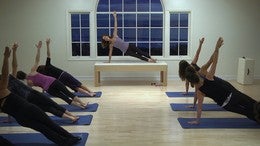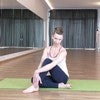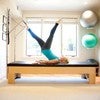Description
About This Video
Transcript
Read Full Transcript
Hello, I'm Madeline black and I'm going to give you a tutorial on the ribcage. So the ribcage has actually divided into four different regions based on how the bones move. So the first region is the vertebro maneuver, IOM, the maneuver IOM is this upper part of the sternum here and the first rib and second rib attached to the maneuver IOM. So rib number one ring and rib number two with the clavicles, uh, create the v t bro Maneuver IOL, uh, region of the thorax and that region, uh, functions primarily for neck movement. So turning the head or especially flection and extension of the neck and also has a lot to do with elevation of the arms.
So this region is designed in the bone area, which really influenced the arm motion. So in my other tutorial, I'm going to go into more detail about that particular region because it's very important in terms of how our work in training our clients, you know, with their arm work, whether they're weightbearing or using the straps or anything like that. So the second region, uh, is very interesting to me and it's really rib three. And you can see here how it's attached to the sternum. So all the ribs that are attached to the sternum is called the v t bro Sternal region of the thorax. So that's ribbed three, four, five, six and seven. All right, seven and eight. Start to go into the, these are called the cartilage here. Alright, the chondral cartilage. So that's a different region here.
So these bones are directly attached to the sternum and the movement there obviously for breathing, uh, there's this motion, uh, that we call like a pump handle where they rotate up and down as you're breathing. The interesting thing about the breathing motion of these ribs is that at the clavicles, uh, up here that also does this rotation, uh, and it's almost a hundred percent motion of pump handle. And as it progresses down through these ribs, it becomes, uh, less and less and less pump handle. And it starts to change into more of that lateral movement. So it's interesting to notice the Briggs rotating up and down and progressive Leigh becoming less pump handle into more of bucket handle.
Right? So, and I'm gonna turn this around. So you could see the back and what's making all of this, uh, motion change is really the shape and angle of the fossette joints, right? So the fossette joints are right here on either side. So it's where one vertebrae kind of overlaps with the underneath a vertebrate here. And that's where our movements, so when we extend the spine, these bones slide downward. They go a little inferior and actually move a little anterior like into the body. All right. And then when you go into flection, they slide up this way superior and they actually move back a little bit, which gives us the, the flection. So this motion would tend the synovial joint here on either side, right?
Cause there's one on each side creates that [inaudible] motion. So as we come down to the ribs, so the rib is attached to has two attachments on one vertebrae. So the, uh, inferior part of the vertebrae, that inferior part is where the superior part of this rib as and the inferior part of the rib is on the superior part of the lower vertebrae. I know it's a lot of inferior superior, but basically when you have the bone, you can see that it's attached to the bottom part of this vertebrate and the top part of that vertebrae. It's a little bit more layman terms there. Okay. So there's a lot of articulation here at this joint and we're going to talk in a moment about the importance of that.
But what I want you to see is how the angle of the fossette joints change. So you can see in the neck, the fossette joints are very flat. It's kind of more a coronal plane. We call that as very, very flat this way. And then as the bones change their shape and you start coming down into that first region of the thorax, the fossette joints start to change a little bit of their angles that are a little bit more transverse and sagittal as opposed to flat. There's a little bit more of an angle to it.
The interesting thing is the very first, uh, thoracic vertebrae is not your ordinary vertebrae because the superior part of that, um, vertebrate acts like a cervical vertebrae. So the angle of the sets actually a little flatter, whereas below on on that first thoracic vertebrae below it, uh, it's, it starts to shape more, uh, in that angle of the transfers sagittal plane here. So here's the t one and the angles. You can see how the angle starts to shift. So t one's very interesting because it acts like a cervical vertebrae on the top and then acts like a thoracic vertebrae on the bottom. Okay. So, um, the region three is really more the chondral part that I showed you in the front ribs seven, eight and nine. And then we have region four, seven, eight, nine and 10. Then region four is, is, are, are floating ribs t 11 and 12. All right, so that's called the, uh, thoracolumbar a juncture, right? T 11 and 12. And uh, t 12 is another interesting, uh, vertebrae because it does a similar thing as t one where t 12 on the top is more like a thoracic vertebrae, but below on the inferior part of t 12, it's more shaped like a lumbar vertebrae.
So that's a very transitional place here between t 12 and l one and the mechanics. So movement wise, um, we have the purest rotation at the TL junction, so that rotation happens, uh, quite easily and you'll see where you ask people to do a twist and movement and they tend to do it down in the TL junction, but don't actually articulate and start moving the vertebraes in the thorax. And that's the point of the rib classes that I'm going to be leading, is that we want to try to get kind of a, a descending and ascending motion throughout this second region, especially into the third region so that all the rotations not happening at the lumbar and the tail junction. Okay. So that's going to be a very important. Now here's an interesting thing about the different bodies and we're going to see this in action in a moment, is that we have three kinds of, um, the way the bones relate to each other, meaning the vertebrae in the rib. So a real mobile thorax is when you go into emotion. So let's say flection. So if I start to flex down through my spine, right?
The, the, the spine is moving, the rib is moving with the vertebrae, correct? Right. So they're moving, then all of a sudden the vertebrae will stop moving inflection and the vertebrae and the ribs will continue moving. So that's a very mobile thorax and it happens in all the planes. So if I'm talking about rotation, so when you start to rotate the vertebraes and the ribs follow along, so the two are going together and then there's a moment where the vertebrates stops moving and that rib can continue moving. And those are your folks who couldn't do a really fantastic, almost 180 degree, you know, twists and some of those movements. Uh, and then the other possibility is that in the motion, so if we're talking about flection, again, as you're going down inflection the vertebrae and the ribs or moving together, and then at some point, actually the rib stops moving and the spine continues to move.
Now we're talking about micro movement. We're not going to displace a rib, but there's a point where, and that's considered a little stiffer, a thorax. So rotate in rotation, it's very obvious. You can really see it is that the spine and the ribs start to move, but the ribs stops. But the person can just crank it a little bit more in. That's the vertebrae continues to move, but the ribs have actually stopped moving. Uh, and then the stiffer, um, thorax is, um, when the two stop together. So those are the three possibilities. Uh, and we're gonna, we're gonna see that.
And it's, it's really good to know that because I see that in people's teaching and movement that when the bone stopped to move and then they try to push it a little bit further, the Fascia and the tissue and the muscle tissue and the ligaments especially, they start to get strained, you know, so they start to stretch beyond the, the length that they should be. And then that cause causes an instability actually in the spine because of that. So we want to be watching as we're watching someone move, not that we can improve some range. It also depends on your age. So in young people, um, you know, probably under 15, I don't know the exact years, but younger people or have a more mobile, uh, thorax in general because they haven't completed their ossification part of the joints yet. So as you start to get older, the bones are getting more ossified and so therefore the movement is restricted. So, you know, even in age, uh, with people, you know, you can be very flexible when you're very young and then as you start to get older, things change a little bit in the bones ossify and you perhaps might see that your ability to maybe twist won't be as great as it was.
Not that you can't twist, it's just not the range that perhaps you had when you were 15 and now you're 60. So, um, that's Kinda the difference there. So mobility in the ribs is important for breathing, uh, but also for our motion, um, just everyday motion and gait patterning when we're walking, there is a rotation in the rib cage that is a natural rotation that I feel that is missing in many people's Gait patterning. And they tend to pull their legs a little bit forward, you know, along the ground. And then they tend to do a rotation at the pelvis instead of getting the rib cage to do the rotation as they're walking.
So the rotation at the pelvis while you're walking, we're really strained. The lumbar spine, the disc, uh, and the tissue there. So people with some hip joint, lower back issues. Uh, you should look at, see how their rib cage is moving because if you can improve even just a few degrees of this, uh, ascending or descending motion, uh, of the ribs in their body, it could really help with the strain on the lower back. And now we're going to take a look at, um, the three different types in action. So now we're going to take a look at three different thorax and how they rotate.
And I'm going to give you a play by play on how the ribs and the spine are moving, either together or not together. So I'm going to start higher up. So I'm in that second region of the thorax. So the vertebrates here, and I'm going to place my fingers along the rib ring here. And then I'm going to ask Amy to slowly, cause I have to do a play by play to slowly rotate to the left. Now her ribs are moving. Now pause for a second. This side of the ribs, which is her right side, started to move forward and this side, her ribs started to go back and the vertebraes moving with that. So now she's going to continue. I'm going to tell you what I feel.
She's still moving and right about here. Okay, pause for a second. The ribs have stopped moving at this point, but I believe if you can think higher too, and not just your waist, Amy, go a little further and I see that her vertebrae is starting to move more and the ribs actually have stopped. And if you notice the tissue is starting to lengthen here. So that's a very say right here. She's starting to um, ab doctor Scapula. So when it's protracting like that basically means that the ribs have stopped moving there. So that's another sign to notice that.
So that that's considered just bony wise in terms of the name is stiff ribs. Um, no judgment there, but that's, I didn't make up the name, but anyway, so, so another example here, I'm going to try to take the same rib now just even from starting. This is very interesting, the difference in the placement of the ribs even where they're starting. So Amy's rib cage, uh, is a little bit more posterior meeting. It's a little bit more rounded back or you could say it's a little bit more inflection. It's, and it's actually the shape of the rib cage.
Uh, we each have a different, you know, the bones, the way the cage is actually shaped and what we need to have in the upper region, especially in the, um, the first region, uh, and a bit of the upper, the second region is that we want those ribs to be kind of leaning back and resting into the scapula. So Amy's rib cage does that very nicely, where the ribs actually really sit into those scapulas. I give an image for clients that the Scapula is like a saddle and that the ribs are actually sitting in that saddle. So it's that feeling, uh, her back's a little bit different where the vertebrates and her upper back is a little more extended so it's a little straighter and the ribs are a little bit more forward to begin with. So her ribs up in this area are not actually sitting back in the saddle of the Scapula. Um, and that's just the nature of her shape and we'll see how it is that she likes to move. So now here's the rib. So she's going to start to rotate to the left, which is actually usually a more difficult way to rotate and, and pause for a second. For most people it's just on average. Okay.
So I already feel at this point that this rib here has stopped on her right side is stop moving forward. Uh, which would mean that since it's a ring and attached to the sternum, um, it would mean the hole, uh, ring is not moving. So there's no right and left side. Let's come back. No right and left side to a ring because of this a, a, a circular bone that's attached to the sternum. Uh, so we were going to do that again. So she's going to rotate to the left. Yeah. And right there it stopped. Right. And she's going to try to go further. I'm going to see if I can feel that her vertebraes are moving into, you can see where she's choosing now to move more in her neck, the lower part of her neck care.
And she's choosing to rotate more here and much less in this area here where I'm at. So come back. So what do we call that? I don't know. We could call that a stiff one too. It's just a different, it's just, it's, no, no, it's just a different shape of the, uh, the rib cage and how we start in a particular place. So you have to realize that the person's starting a little bit more in extension than flection. And that's gonna make their movement patterning change. That's it. So now Aaron, we have an example of a more of that will mobile ribs that I had mentioned. So her vertebraes here, and I'm going to go onto the rib here and she's going to start rotating to the left. So the ribs are moving and keep going.
She's going, the ribs are going okay, now stop. The spine actually stopped moving, so she's going to continue a little further and I still feel those ribs. You can see how my fingers really going deep, deep, deep into her tissue there. So her ribs are still continuing to move. So this is a, an example of the mobile ribs, so she can actually probably can, can continue. And you'll notice that as she's doing that, she's not actually protracting or retracting too much on the scapula and come back down. So she has a nice way. Just do a slow rotation.
If you start up here, you can see this as moving, then this is moving. She's got that what I call that descending motion through her thorax to keep moving, right. And then come back. So it's a nice mobile, uh, example of how her bones are actually designed in the movement. So, you know, the consideration with people's spines is what is the architecture of their bone, of their spines. And some people have, you know, more prominent spinus processes, which it will eliminate extension. Uh, some people's, as I say, their ribs don't stop moving with the vertebrae or the vertebrae keeps moving. There's these different designs that each of us have. So when you pay attention to that, it really can have a great impact on somebody's ability to get more mobility in the ribs and to also strengthen the core. Because when we're talking about this rotation, we've got the obliques happening in the ribs having to move through that.
So now we've seen three different variations of rib movements, even though I gave them a name. Um, it's just becoming aware of how is it that your design of your ribs and your spine in your body actually move? Can you feel that or can someone, you know, work with you and try to help you understand that feeling? And why is that important to know? If I know that I can feel that my ribs stop moving and my vertebrae continues to move, that I'm going to pay attention to the range of motion that I choose to do in a Palladio's or a yoga, um, movement. How much do I try to optimize and get that maximum twist, which really is not possible within the architecture of my body.
And it's not a training effect. It's not that you can keep doing twist every day and then eventually, you know, your bones are actually going to change. Also depends on your age, but so the takeaway for this is to pay attention to what your dynamics and your architecture is with your ribs. And you work within that a range of motion with the resistance to benefit the strength that you have that you can achieve. So enjoy moving your rib cage and all activities in any of your platas classes.
Comments
I especially loved seeing a variety of demonstrations. It was an incredibly useful and effective tool to demonstrate your point. Worth much more than 1,000 words!

Thank you Madeline! Love your classes 💕💕
You need to be a subscriber to post a comment.
Please Log In or Create an Account to start your free trial.























